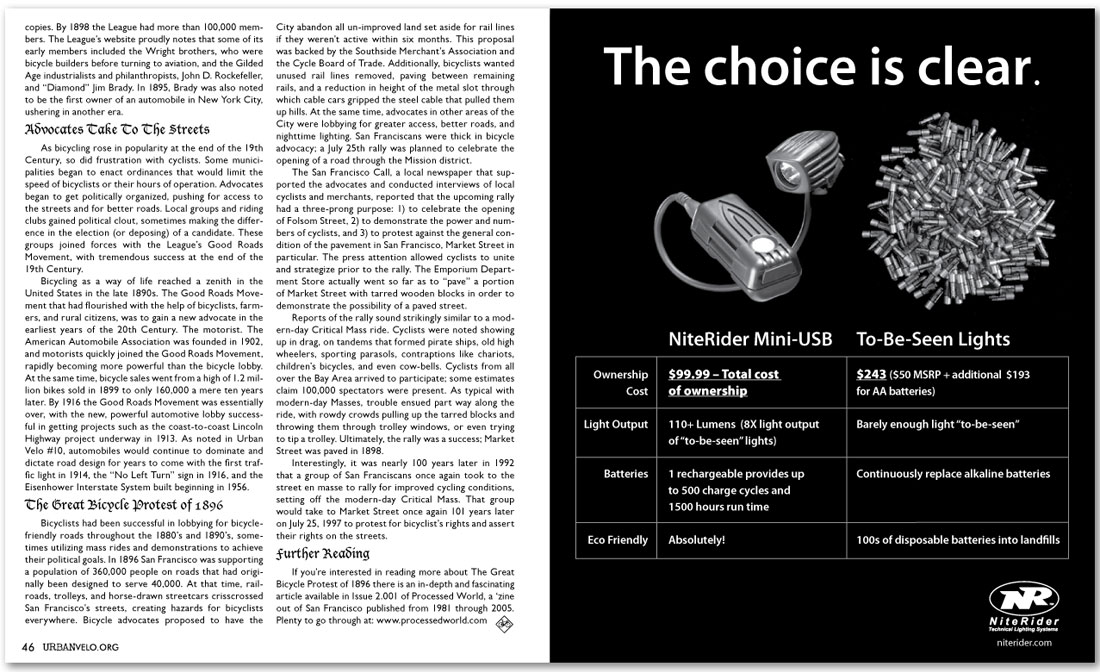

|
|||
copies. By 1898 the League had more than 100,000 members. The League’s website proudly notes that some of its early members included the Wright brothers, who were bicycle builders before turning to aviation, and the Gilded Age industrialists and philanthropists, John D. Rockefeller, and “Diamond” Jim Brady. In 1895, Brady was also noted to be the first owner of an automobile in New York City, ushering in another era. Advocates Take To The Streets As bicycling rose in popularity at the end of the 19th Century, so did frustration with cyclists. Some municipalities began to enact ordinances that would limit the speed of bicyclists or their hours of operation. Advocates began to get politically organized, pushing for access to the streets and for better roads. Local groups and riding clubs gained political clout, sometimes making the difference in the election (or deposing) of a candidate. These groups joined forces with the League’s Good Roads Movement, with tremendous success at the end of the 19th Century. Bicycling as a way of life reached a zenith in the United States in the late 1890s. The Good Roads Movement that had flourished with the help of bicyclists, farmers, and rural citizens, was to gain a new advocate in the earliest years of the 20th Century. The motorist. The American Automobile Association was founded in 1902, and motorists quickly joined the Good Roads Movement, rapidly becoming more powerful than the bicycle lobby. At the same time, bicycle sales went from a high of 1.2 million bikes sold in 1899 to only 160,000 a mere ten years later. By 1916 the Good Roads Movement was essentially over, with the new, powerful automotive lobby successful in getting projects such as the coast-to-coast Lincoln Highway project underway in 1913. As noted in Urban Velo #10, automobiles would continue to dominate and dictate road design for years to come with the first traffic light in 1914, the “No Left Turn” sign in 1916, and the Eisenhower Interstate System built beginning in 1956. The Great Bicycle Protest of 1896 Bicyclists had been successful in lobbying for bicycle-friendly roads throughout the 1880’s and 1890’s, sometimes utilizing mass rides and demonstrations to achieve their political goals. In 1896 San Francisco was supporting a population of 360,000 people on roads that had originally been designed to serve 40,000. At that time, railroads, trolleys, and horse-drawn streetcars crisscrossed San Francisco’s streets, creating hazards for bicyclists everywhere. Bicycle advocates proposed to have the City abandon all un-improved land set aside for rail lines if they weren’t active within six months. This proposal was backed by the Southside Merchant’s Association and the Cycle Board of Trade. Additionally, bicyclists wanted unused rail lines removed, paving between remaining rails, and a reduction in height of the metal slot through which cable cars gripped the steel cable that pulled them up hills. At the same time, advocates in other areas of the City were lobbying for greater access, better roads, and nighttime lighting. San Franciscans were thick in bicycle advocacy; a July 25th rally was planned to celebrate the opening of a road through the Mission district. The San Francisco Call, a local newspaper that supported the advocates and conducted interviews of local cyclists and merchants, reported that the upcoming rally had a three-prong purpose: 1) to celebrate the opening of Folsom Street, 2) to demonstrate the power and numbers of cyclists, and 3) to protest against the general condition of the pavement in San Francisco, Market Street in particular. The press attention allowed cyclists to unite and strategize prior to the rally. The Emporium Department Store actually went so far as to “pave” a portion of Market Street with tarred wooden blocks in order to demonstrate the possibility of a paved street. Reports of the rally sound strikingly similar to a modern-day Critical Mass ride. Cyclists were noted showing up in drag, on tandems that formed pirate ships, old high wheelers, sporting parasols, contraptions like chariots, children’s bicycles, and even cow-bells. Cyclists from all over the Bay Area arrived to participate; some estimates claim 100,000 spectators were present. As typical with modern-day Masses, trouble ensued part way along the ride, with rowdy crowds pulling up the tarred blocks and throwing them through trolley windows, or even trying to tip a trolley. Ultimately, the rally was a success; Market Street was paved in 1898. Interestingly, it was nearly 100 years later in 1992 that a group of San Franciscans once again took to the street en masse to rally for improved cycling conditions, setting off the modern-day Critical Mass. That group would take to Market Street once again 101 years later on July 25, 1997 to protest for bicyclist’s rights and assert their rights on the streets. Further Reading If you’re interested in reading more about The Great Bicycle Protest of 1896 there is an in-depth and fascinating article available in Issue 2.001 of Processed World, a ‘zine out of San Francisco published from 1981 through 2005. Plenty to go through at: www.processedworld.com |
|
|